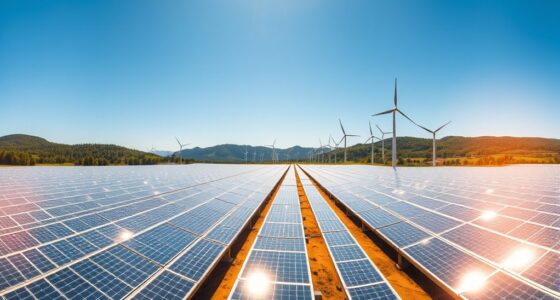To design an off-grid solar system, start by accurately calculating your daily energy needs, factoring in cloudy days and nighttime use. Choose batteries with enough capacity for periods without sunlight, and pick an inverter that matches your total load with ample surge capacity for startup. Plan for future expansion by selecting compatible components and proper wiring. Also, consider environmental conditions like shading and temperature to optimize efficiency. Keep exploring to get a detailed step-by-step approach for a reliable setup.
Key Takeaways
- Estimate daily energy needs, including cloudy days and nighttime, to properly size components.
- Select batteries with adequate capacity to ensure reliable power during low sunlight periods.
- Choose an inverter that matches your load requirements, considering surge capacity for high-startup devices.
- Plan for system expandability by selecting compatible components and allowing future growth.
- Assess environmental conditions like shading and weather to optimize system placement and performance.

Designing an off-grid solar system begins with understanding your energy needs and the location where you’ll install it. Once you’ve determined your daily power consumption, you can start planning the core components. One of the most crucial considerations is battery storage because it guarantees you have a reliable power source when the sun isn’t shining. You need to estimate how much energy you’ll require during cloudy days or at night, then select batteries that can store enough capacity to cover these periods without draining completely. Lithium-ion batteries are popular for their efficiency and long lifespan, but lead-acid options can also work depending on your budget and storage needs. Properly sizing your battery bank prevents under- or over-sizing, which can lead to system inefficiencies or unnecessary expenses.
Start with your energy needs and battery storage to ensure a reliable off-grid solar system.
Alongside battery storage, inverter selection is equally essential. The inverter converts the DC power generated by your solar panels into usable AC power for your home or equipment. Choosing the right inverter depends on your total load and the types of devices you plan to run. For example, if you have high-startup appliances like refrigerators or power tools, you’ll need an inverter capable of handling surge power. Pure sine wave inverters are generally recommended because they produce cleaner power, protecting sensitive electronics and ensuring they operate smoothly. When selecting your inverter, consider its continuous wattage rating, efficiency, and whether it’s compatible with your battery type and voltage. Oversizing the inverter slightly can provide extra headroom for sudden power demands, but avoid excessively large units that increase costs without proportional benefits.
In addition to these technical choices, you should also think about system expandability and future needs. Your initial setup might only support your current consumption, but as your needs grow, you may want to add more panels, batteries, or a larger inverter. Planning for this flexibility can save you money and effort later on. It’s also important to ensure that all components are compatible and meet safety standards. Proper wiring, grounding, and fuse protection are essential to prevent electrical issues and ensure longevity.
Finally, don’t forget to account for environmental factors like shading, temperature, and weather conditions at your installation site. These influence the performance of your system components, especially batteries and inverters. Additionally, understanding the typical juice yield from citrus fruits can help you optimize your harvesting and storage strategies if you plan to incorporate renewable resources beyond solar. By carefully selecting the right battery storage and inverter, based on your energy profile and site conditions, you create a resilient off-grid system that reliably meets your needs. This foundational step sets the stage for a sustainable, efficient, and cost-effective off-grid power solution.
Frequently Asked Questions
How Do Weather Variations Affect Off-Grid Solar System Performance?
Weather variations greatly impact your off-grid solar system performance. Solar radiation variability caused by cloudy days, rain, and snow reduces the energy your panels produce. Seasonal weather impacts, like shorter winter days and lower sun angles, decrease sunlight exposure. You should plan for these fluctuations by sizing your system appropriately, incorporating storage, and considering seasonal adjustments to ensure reliable power throughout the year.
What Are the Best Battery Types for Off-Grid Solar Setups?
When selecting batteries for your off-grid solar setup, consider lithium-ion batteries, which are renowned for their impressive longevity and high capacity. They offer a longer lifespan and better performance under varying conditions, making them an elegant choice. While slightly more costly upfront, their durability and efficiency can save you money over time. Lead-acid batteries, though more affordable initially, may require more frequent replacements, impacting overall system reliability.
How Often Should Off-Grid Solar System Components Be Maintained?
You should inspect your off-grid solar system components, including batteries, at least every 6 to 12 months to guarantee peak performance. Regular component inspection helps extend battery lifespan and catch issues early. Keep an eye on connections, voltage levels, and signs of wear. Proper maintenance, including cleaning and monitoring, keeps your system running efficiently and prevents costly repairs, ensuring your off-grid setup remains reliable year-round.
Can Off-Grid Solar Systems Be Expanded Easily Later?
Imagine your solar setup as a sturdy tree, ready to grow. Yes, off-grid solar systems are designed with modular components, making expansion simple. You can add more panels, batteries, or inverters as your power needs increase, thanks to scalability options. This flexible design lets you adapt your system over time, ensuring it continues to meet your energy demands without a complete overhaul, just like nurturing a growing tree.
What Are the Common Challenges in Off-Grid Solar System Installation?
You’ll face challenges like ensuring battery safety, as improper handling can cause hazards. Accurate system sizing is essential; underestimating your energy needs leads to power shortages, while overestimating adds unnecessary costs. Installing panels correctly and managing wiring also pose difficulties. Planning ahead, following safety protocols, and consulting experts help you overcome these common hurdles, ensuring a reliable and safe off-grid solar setup that meets your energy demands efficiently.
Conclusion
By understanding the basics of off-grid solar system design, you realize that every component works together like a well-tuned orchestra. When you plan carefully, you might find that your energy needs align perfectly with the sun’s natural rhythm, almost as if it was meant to be. Sometimes, the simplest choices lead to the most reliable power. In this way, your off-grid system becomes more than just a setup — it’s a harmony rooted in nature’s own design.









